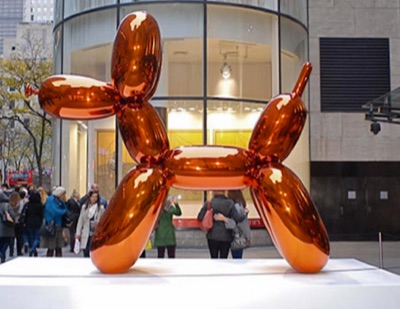
This is ‘Balloon Dog (Orange)’, a sculpture by New York ‘appropriation artist’, Jeff Koons. It’s made of colored, mirror-finished stainless steel.
[author_more]
[/author_more]
In 2013, this piece sold for more than $58 million – the current world record for an artwork sold by a living artist. Koons has a made a glittering career playing with themes of the ‘banality of modern life’.
Jeff thinks about ‘banality’ quite a lot for a guy with enough money to BUY Disneyland!
Anyway…
Jeff Koons also regularly gets sued for plagiarism – he’s had three significant court cases to date. While he arguably has problems specific to millionaire appropriation artists, there are probably some useful lessons for us.
Today I thought we’d focus on his first copyright case – the sequels are never quite as good, right?
Rogers Vs. Koons
Back in the early-90’s, photographer Art Rogers sued Jeff Koons for infringing Rogers’ photo titled ‘Puppies‘ (1985) – a black and white image used mostly on greeting cards and postcards.

Koons created his ‘String of Puppies’ sculpture series in 1988 and later freely admitted using Rogers’ photograph as the basis of the work.

In court, Koons cited two defences we still often hear today:
- Fair use: the legal, unlicensed citation or incorporation of copyrighted material in another author’s work under a four-factor test.
- Parody: an imitation of the style of a particular writer, artist, or genre with deliberate exaggeration for comic effect.
Koons lost the case.
Why Couldn’t Koons Claim ‘Fair Use’?
We hear the ‘fair use’ concept cited often on the web. In fact, there’s an often quotes belief that a 20% change from the original work is enough to protect you.
There is no truth to that idea. How would you even begin to measure it?
Koons changed media, added colors, flowers, strange dog noses and even the modelling itself isn’t a particularly close replica of the photo. But that still wasn’t enough.
There are two main parts to determining whether copyright has been infringed. Firstly, can the original creator prove it owns the rights to the work? Art Rogers certainly owned the original photo rights.
The second part asks whether the ‘average person’ viewing the work would recognize that one was copied from the other. It’s hard to imagine anyone believing Koons’ composition was random chance.
In short, changing the media and some detail is no shortcut to a fair use defence.
Continue reading %Puppies (Or Fun Ways to Get Sued for Copyright Infringement)%
Source: SitePoint